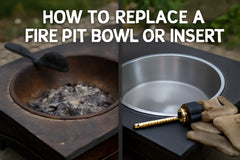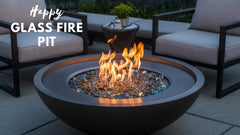How do Smokeless fire pits work
Smokeless fire pits are convenient and versatile heating system to produce heat and warmth in your house during withers. Smokeless fire pits are specially designed fire pits that produce very minimal smoke while burning wood or other fuels. It works by secondary combustion which means it burns off the smoke and gases before they escape into the air. While it is impossible to eliminate smoke entirely, these fire pits use a specialized airflow system to burn wood or fuel more efficiently, reducing the amount of smoke generated. They rely on a double combustion which not only minimizes smoke but also improves fuel efficiency and provides a more enjoyable experience for users.
The First Burn
Smokeless fire pits use two step combustion to reduce the smoke and other residue like ashes and remaining. The first burn also known as initial or primary combustion, it is the first stage of combustion. It is similar to that of a traditional fire pit. The fuel usually wood or charcoal is ignited at the base of the pit. As it burns, it releases gases, water vapor and fire particulate matter. In a conventional fire pit, some of these components escape into the air as smoke. However, in a smokeless fire pit, a controlled airflow system ensures that more oxygen reaches the base of the fire promoting a hotter and more efficient burn. This process alone helps reduce the initial smoke output compared to an open fire.
Second Burn
The second step is to burn the smoke to eliminate most of it. It is called second burn or secondary combustion that is the key to reducing smoke. The secondary combustion phase is what truly differentiates a smokeless fire pit from a traditional one. The double-wall design includes strategically placed holes or vents that draw in air from outside. This air is heated as it passes through the wall of the fire pit and is then released into the upper part of the combustion chamber. It reignites them creating secondary burn. This process results in a more complete combustion cycle burning excess smoke before it has a chance to escape into the air. Because the secondary combustion process burns off additional fuel components, the flame in a smokeless fire pit tends to be cleaner and more intense, this not only enhances the visual appeal of the fire but also improves heat output.
How it works?
Traditional fir pits often produce smoke due to incomplete combustion. When wood or other fuel burns, it releases volatile organic compounds along with water vapor and gases like carbon monoxide, incomplete combustion results in partially burned particles that rise into the air as smoke. Smokeless fire pits are made to increase combustion efficiency, reducing the amount of unburned material released into the air. The key to smokeless fire pits lies in their design which promotes optimal airflow. They are typically constructed with a double-wall system that allows for preheated air to enter the combustion chamber. This ensures that the fuel burns more completely, significantly reducing the production of smoke. There are two processes involved in this combustion the first one is primary combustion and second one is secondary combustion. Both of which play an important part in minimizing the smoke.
Material Used in Smokeless Fire Pits:
There are some suitable materials that are used to make a smokeless fire pit. These materials are perfect for a fire pit and to resist extremely high temperatures. Smokeless fire pits are typically made from durable, heat-resistant material that can withstand high temperatures. Stainless steel is a common choice due to its resistance to rust and corrosion. Stainless steel is a common choice due to its resistance and common corrosion. It also retains heat well, allowing for consistent combustion. Some models use cast iron which is heavier but excellent for heat retention and longevity. Other fire pits incorporate heat-resistant alloys or ceramic coating to enhance performance and durability. The choice of material affects not only the fire pit’s lifespan but also its ability to conduct and radiate heat efficiently.
Pros of a Smokeless Fire Pit:
One of the biggest advantages of a smokeless fire pit is the reduction of smoke which enhances the overall experience of sitting around a fire. Traditional fire pits often cause irritation due to excessive smoke, leading to watery eyes, coughing and unpleasant odors on clothing. A smokeless fire pit significantly mitigates these issues making it more comfortable for users. Another major benefit is improving fuel efficiency. Because smokeless fire pits promote complete combustion, they use less wood while producing the same amount of heat. This means that users can enjoy a longer-lasting fire with fewer logs, ultimately saving money and reducing the environmental impact of wood consumption. Smokeless fire pits also offer a cleaner burn, resulting in less soot and ash buildup. This reduces the amount of maintenance required as there is less residue left to clean after each use. Additionally, the secondary combustion process helps minimize the release of harmful pollutants making these fire pits a more environmentally friendly option compared to traditional wood-burning fires.
Maintenance of a smokeless fire pit:
It is very important to maintain and clean the products that you use for your benefit. If you don’t keep them clean and don’t pay attention to their maintenance they will get out of order and it will cost you very high to repair or replace. The maintenance of a smokeless fire pit is very important to make sure that it works properly and remains in good condition. Regular cleaning is important to remove dirt, ashes and remaining which can obstruct airflow and reduce performance. For wood-burning fire pits, it is recommended to empty the ash pan after each use and periodically inspect the vents to prevent clogging. Gas-powered models should be checked for gas leaks and cleaned according to the manufacturer’s guidelines. Storing the fire pit in a dry, sheltered location when not in use helps prevent rust and weather damage. Some models come with protective covers that shield them from moisture and debris. If the fire pit is used frequently, occasional deep cleaning with a mild detergent and a soft brush can help maintain its appearance and functionality.
Conclusion:
Smokeless fire pits are an excellent alternative to traditional fire pits, offering a cleaner, more efficient way to enjoy an outdoor fire. By utilizing advanced airflow and secondary combustion, they significantly reduce smoke output while enhancing fuel efficiency and heat production. With various types, materials and features available, users can find a smokeless fire pit that suits their needs whether for camping, backyard gatherings or patio relaxation. Investing in a well-designed smokeless fire pit not only enhances the fire experience but also contributes to a more sustainable and enjoyable outdoor environment.






